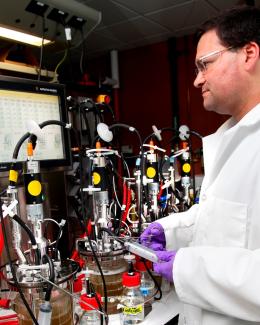Abstract
Clostridium thermocellum is capable of solubilizing and converting lignocellulosic biomass into ethanol. Though much of the work-to-date has centered on characterizing the organism’s metabolism during growth on model cellulosic substrates, such as cellobiose, Avicel, or filter paper, it is vitally important to understand it metabolizes more complex, lignocellulosic substrates to identify relevant industrial bottlenecks that could undermine efficient biofuel production. To this end, we have examined a time course progression of C. thermocellum grown on switchgrass to assess the metabolic and protein changes that occur during the conversion of plant biomass to ethanol. The most striking feature of the metabolome was the observed accumulation of long-chain, branched fatty acids over time, implying an adaptive restructuring of C. thermocellum’s cellular membrane as the culture progresses. This is likely a response to the gradual build-up of lignocellulose-derived inhibitory compounds detected as the organism deconstructs the switchgrass to access the embedded cellulose and includes 4-hydroxybenzoic acid, vanillic acid, ferulic acid, p-coumaric acid and vanillin. Corroborating the metabolomics data, proteomic analysis revealed a corresponding time-dependent increase in enzymes involved in the interconversion of branched amino acids valine, leucine and isoleucine to iso- and anteiso-fatty acid precursors. Furthermore, the metabolic accumulation of hemicellulose-derived sugars and sugar-alcohols concomitant with increased abundance of enzymes involved in C5 sugar metabolism / the pentose phosphate pathway, indicate that C. thermocellum either shifts glycolytic intermediates to alternate pathways to modulate overall carbon flux or is simply a response to C5 sugar metabolite pools that build during lignocellulose deconstruction.






